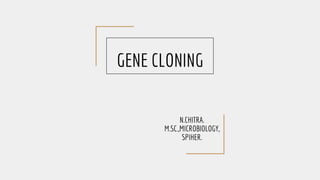
Gene Cloning Methods and Techniques
- 2. GENE CLONING : ➢ The production of exact copies of a particular gene or DNA sequence using genetic engineering techniques is called gene cloning. ➢ The use of the word cloning refers to the fact that the method involves the replication of one molecule to produce a population of cells with identical DNA molecules. ➢ Molecular cloning generally uses DNA sequences from two different organisms: the species that is the source of the DNA to be cloned, and the species that will serve as the living host for replication of the recombinant DNA.
- 3. The basic 7 steps involved in gene cloning are: ➢ Isolation of DNA [gene of interest] fragments to be cloned. ➢ Insertion of isolated DNA into a suitable vector to form recombinant DNA. ➢ Introduction of recombinant DNA into a suitable organism known as host. ➢ Selection of transformed host cells and identification of the clone containing the gene of interest. ➢ Multiplication/Expression of the introduced Gene in the host. ➢ Isolation of multiple gene copies/Protein expressed by the gene. ➢ Purification of the isolated gene copy/protein.
- 5. METHODS OF GENE TRANSFER : ➢ A genetic engineering technique to transfer genes using vectors from one organism to another or from one cell to another in order to treat disease, construct genetically modified organisms (GMO) and economically important organisms are known as gene transfer.
- 7. BACTERIAL TRANSFORMATION : In molecular biology, transformation is genetic alteration of a cell resulting from the direct uptake, incorporation and expression of exogenous genetic material (exogenous DNA) from its surroundings and taken up through the cell membrane(s).
- 8. ➢ The naked DNA is used to fuse the complex with a chemical agent (and therefore it is also known as naked-DNA mediated gene transfer). ➢ The chemical and DNA complex either interact with the cell wall or membrane or processed through endocytosis. ➢ Once it enters into the cell cytoplasm, the DNA is released from the chemical agent and incorporated into the genome.
- 10. There are four steps in transformation: ➢ development of competence, ➢ binding of DNA to the cell surface, ➢ processing and uptake of free DNA (usually in a 3’ to 5’ direction), and ➢ integration of the DNA into the chromosome by recombination.
- 11. ELECTROPORATION : ➢ The electroporation technique is one of the commonest and successful methods used so far by scientists. ➢ In this method, the gene of interest or the DNA is transferred into the target cell under the influence of an electrical pulse. ➢ Under the pulse electric current, pores are created in the cell wall or the plasma membrane of a cell which allows DNA intake. ➢ Once the electrical current discharged, the pores closed. The electroporation method is used for both stable and transient gene expression.
- 14. In microbiology, the process of electroporation is often used to transform bacteria, yeast, or plant protoplasts by introducing new coding DNA.
- 15. TRANSFECTION : ➢ Transfection is the process of deliberately introducing naked or purified nucleic acids into eukaryotic cells. ➢ It may also refer to other methods and cell types, although other terms are often preferred: "transformation" is typically used to describe non-viral DNA transfer in bacteria. ➢ Although there are many ways to deliver genes to cells, there are three highly recognized methods researchers utilize today: chemical reagents, electroporation (gene electrotransfer) and viral transduction.
- 16. CHEMICAL TRANSFECTION : ➢ Transfections using chemical transfection reagents rely on electrostatic interactions to bind with nucleic acids and to target cell membranes. ➢ This can be achieved with compounds like calcium phosphate, polycations, and liposomes or more current technologies such as cationic lipids, polymers, dendrimers, and nanoparticles. ➢ Using calcium phosphate for delivery is the oldest and least expensive way to introduce nucleic acids into cells. This technique works well in some easy to transfect cell lines, but cannot deliver to more resistant cells, requires large amounts of DNA, and often lacks reproducibility.
- 17. Chemical Transfection of Eukaryotic Cells. 1) Reagent is combined with nucleic acid to form positively charged complexes. 2) Complexes are added to cells, and bind to the negatively charged cell surfaces via electrostatic interactions. 3) Cells internalize complexes via endocytosis into membrane vesicles known as endosomes. 4) Reagent destabilizes endosomal membrane . 5) Complexes escape from endosomes and release nucleic acid cargo in cytoplasm (siRNA, miRNA, or large RNA are generally active in cytoplasm). 6) DNA must localize to the nucleus, where gene expression cassette is transcribed.
- 19. MICROINJECTION : ➢ Microinjection allows for the efficient transfer of controlled nucleotide amounts into the nucleus of a specific target cell. ➢ It is a very precise, but time-consuming and expensive transfection method with a very low throughput only. ➢ Microinjection is mostly used for special applications, such as single cell manipulation or the generation of transgenic animals, e.g., by pronuclear injection in mice.
- 21. Diagram of the intracytoplasmic sperm injection of a human egg. Micromanipulator on the left holds egg in position while microinjector on the right delivers a single sperm cell.